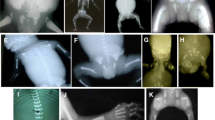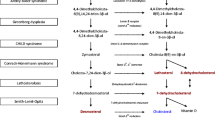Abstract
A case of neonatal-onset glutaric acidemia type II with electron-transfer flavoprotein (ETF) deficiency is presented. The morphological pattern of disease in the male infant included hypospadias, cryptorchidism, bilateral 13 ribs, nuclear cataract, cystic dysplasia of kidneys, lipid accumulation in the liver and renal tubular epithelium, and immature brain with white matter gliosis. The morphologic examination of the placenta revealed features of delayed maturation, including large-for-gestational-age size and abundant immature intermediate villi with cellular syncytiotrophoblast, persistent villous cytotrophoblast, and decreased syncytial knots. In addition, immature intermediate villi showed exaggeration of lacunar interstitial spaces consistent with nonhydropic villous edema. Marked lipid accumulation was seen within extravillous trophoblasts of placental septa and cell islands. Light lipid accumulation was also noted within fibroblasts of stem villi. These findings suggest that in glutaric acidemia type II, fatty acid oxidation could also be affected in the placenta.
Similar content being viewed by others
Author information
Authors and Affiliations
Rights and permissions
About this article
Cite this article
Slukvin, I., Salamat, M. & Chandra, S. Morphologic Studies of the Placenta and Autopsy Findings in Neonatal-onset Glutaric Acidemia Type II. Pediatr. Dev. Pathol. 5, 315–321 (2002). https://doi.org/10.1007/s10024-001-0213-0
Issue Date:
DOI: https://doi.org/10.1007/s10024-001-0213-0




